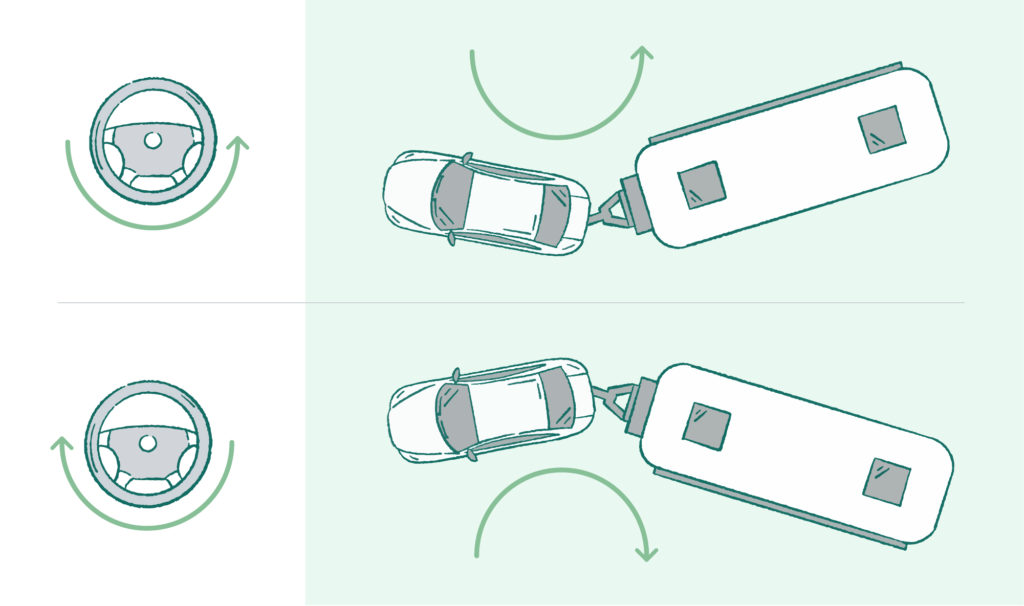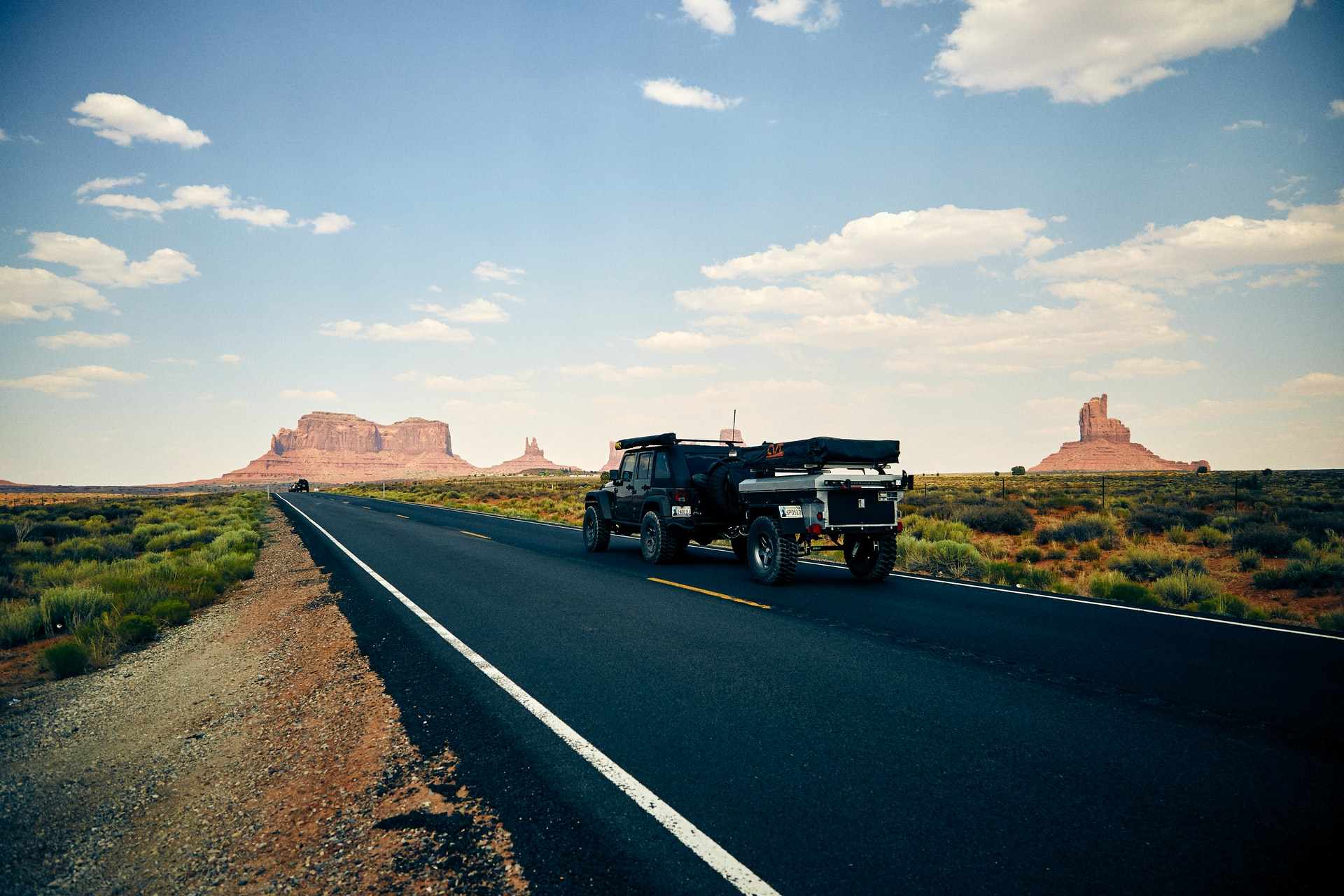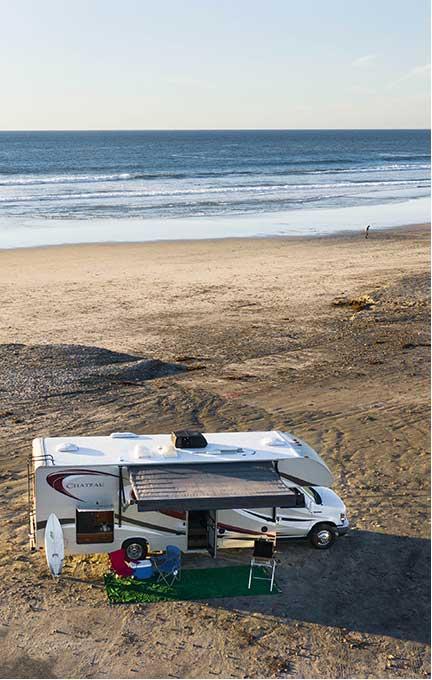Towing a travel trailer is pretty straightforward once you know what to expect. Lucky for you, we’re here to tell you all about it.
We’ll cover:
- How to Prepare
- What to Know Before You Go
- Safety on the Road
Prepare Properly
To ensure the safest and simplest trip possible, you should check a few things before you go.
- The Hitch
- Visibility
- Brakes and Brake Controller
Hitching Your Vehicle
The most important trailer safety tip is to make sure your vehicle is hitched correctly. Make sure your hitch is on and locked in and that your cables are connected and working.
Pay attention to weight distribution. You need a nice flat plan between your tow vehicle and trailer. There should be no tipping towards or away from the hitch. The most accurate way to check weight distribution is to go to a truck scale and have them measure the weight on all your tires. Still, if you are parked on a flat surface, you can generally get a good feel for it just by eyeballing it.
Confirming Visibility
Unless you have backup cameras, your view is limited to what you can see in your side mirrors. So, make sure you have a good view of the rear of your trailer through both.
Visibility too limited? Buy side mirror extensions meant to give you a wide-angle view for towing.
Checking Brakes and Brake Controller
Before hitting the road, you’ll want to ensure the brake controller is properly configured. This controller is what turns on trailer brakes when you activate your tow vehicle’s brakes.
To test the brake controller:
- Get up to about 10 mph.
- Apply the brakes as you would at a normal stop.
- As you stop, check that the trailer is tugging back on the vehicle a bit.
If you don’t feel it tug, or you feel it pushing you, then you need to turn the brake controller setting higher. If the stop feels jerky, then turn the setting down. Ideally, you want the trailer to brake just a little more than the towing vehicle.
Be in the Know
A little trip planning goes a long way. It’s important to know two things:
- Your Trailer Height
- Your Route
Trailer Height
This is crucial information to ensure you don’t drive under a bridge that’s too low. Find out your height, add a foot, and avoid any passages with lower clearance.
Route Planning
Your ability to make split decisions is more limited with a trailer in tow, especially on narrow roads or urban areas. You can get navigation systems that include settings for RVs.
Along with plotting the best route, these systems will:
- Steer you clear of low clearance passages
- Keep you off narrow, one-way roads
- Give you the proper speed for your vehicle
Drive Safely
Driving a travel trailer comes relatively easy but not without its special challenges or dangers, including:
- Turning
- Backing Up
- Hills
- Braking
- Trailer Sway
- Highways
Let’s discuss.
Turning
The trailer will naturally follow the path of your tow vehicle. The only rule of thumb is: the longer the trailer, the wider you should turn. Keep your turn as wide as the roadway permits, and you should be fine with most right-angle turns, curves, and roundabouts.

When possible, avoid any turns sharper than 90 degrees. When necessary, just take them as wide as possible. And as with any turn, don’t take it too fast. Trailers have a higher center of gravity, which means they are more susceptible to tipping over if you take a turn too fast!
Backing Up
One of the most challenging parts of towing a trailer is reversing. The way a trailer backs up is not intuitive and takes getting used to before it feels natural. Here’s a visual guide to help you out.

The more dramatic the turn of your wheel, the faster it will grow sharper. Go too sharp, and you can get jackknifed (aka locked up). You want to avoid this!
Practice reversing before you go and avoid situations that require reversing under pressure!
Hills
Steep hills and mountain passes can prove challenging, especially if you are pushing the boundaries of your tow rating. That said, as long as you know what to do, you’ll be fine!
Going Up
When going up a hill, the main thing to keep in mind is to keep right and if you’re going well below the speed limit, turn on your hazard lights!
Going Down
Going downhill is a bit more dangerous. Engine braking is a good practice if you have the option. This will put your engine into a lower gear as you descend, allowing you to take your foot off the accelerator as the drivetrain runs the engines, and the mechanical resistance slows your descent. This controls your speed and eases up the wear of your brakes.
That said, you may still have to apply your brakes, especially with steep grades. Avoid braking hard while turning and going downhill as this can lead the trailer to jackknife. Keeping a nice, steady, controlled speed is the key to safety in this situation.
Braking
The one thing to keep in mind is that your stopping distance is longer, so you’ll want to give yourself more time and more room to stop. Keep a good distance between you and the car in front of you.
Trailer Sway
The phenomenon of trailer sway is best described as the trailer and tow vehicle wiggling back and forth. What happens is that something pushes on the trailer, and it, in turn, pushes on the tow vehicle. The back and forth reaction makes the sway action grow stronger until it causes a catastrophic crash.
To avoid trailer sway:
- Have good weight distribution on your trailer.
- Avoid driving in high winds.
- Don’t drive too fast.
The cause of sway that is hardest to avoid is people passing your trailer at a much higher speed.
If you do start to feel a sway, do not try and correct the sway by counter steering! This actually enhances the swaying. So, what should you do?
Stopping Sway
The best thing to do is to use the manual trailer brake on your brake controller, which will cause the trailer brakes to engage and pull back on the tow vehicle, forcing it back into a straight line. Practice this braking in an empty parking lot to get a feel for it. For minor sway, your regular brakes may work just fine.
If braking would be dangerous, a second method is to temporarily hit the gas and steer straight. The tow vehicle will pull harder on the trailer and yank it straight. However, the faster you go, the stronger the swaying forces can become, so be cautious with this second technique.
Highway Driving
When it comes to highways:
- Use the Right Lanes
- Don’t Speed
Stay Right
In general, slower-moving and larger vehicles are required to keep to the right lanes on the highway whenever possible. A trailer, due to its size, can be harder to merge with other traffic, so the challenge arises when there are many on and off-ramps. In this case, a middle lane may be your best bet if that option is available.
Slow Your Roll
It’s much more important to arrive in one piece than it is to arrive in record time. Every trailer has a speed at which it becomes unsafe. Never go faster than feels safe. If there’s a long line of cars behind you, pull over and let them pass instead of speeding up.
And, when you do need to change lanes or make a turn, be sure to give other drivers ample time to react by using your turn signals early and often.
Happy Trails!
Towing a travel trailer isn’t as tough as one might think, and now you know all you need to do it with ease. Happy trails and happy towing!








